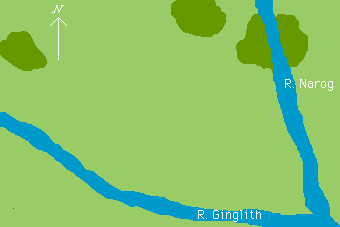Luke Ueda-Sarson's Fantasy Battle Scenarios for DBM:
The Field of Tumlahad: First Age


After defeating the Noldor Elves at the great battle of Nirnaeth Arnoediad, Morgoth had but two of their realms to destroy: Gondolin and Nargothrond. The destruction of Nargothrond, an underground city lying by the river Narog, he entrusted to the Uruloki, or dragon, Glaurung, along with an army of Orcs.
The Elves of Nargothrond, under Orodreth their King, issued forth to give battle, thinking the invaders less numerous than they were. In the field of Tumlahad, between the Narog and Ginglith rivers, they were utterly defeated, Orodreth being slain. Denuded of defenders, the city was quickly sacked after the battle.

The scant details given above are most of what can be found out about the battle (taken from The Silmarillion). The battle took place in the field of Tumlahad - since the Elves are described as being pressed back between the two rivers, we can assume these rivers should feature on the battlefield - the Elves would hardly be constricted by their presence unless the battle was fought in close proximity to them.
The Narog was fordable (Mablung crossed the river on foot at Nargothond), but was still an obstacle, which was why a great bridge was built over it at Nargothrond; it's fordability is probably best classed as 'tricky'. The Ginglith appears to be a slightly smaller river, and is probably best classed as 'easy'.
The field itself is said to be a plain, and thus should be devoid of hills. Given the report that the Elven scouts were mistaken in size of the enemy's force, there should be several ambush sites available to the attackers - most likely woods, since trees grew in the area around Nargothrond (as revealed in the Narn-i-hin-Hurin in Unfinished Tales). I would envisage a battlefield something like the one proposed below:

The battle was fought in late Autumn, with strong winds blowing, direction unkown. Since the effect of the Dragon's fire was so great, we should say they start the battle blowing in a southerly direction. The battle must have been started relatively early in the day, as there was plenty time for survivors to reach Nargothrond; say 10 o'clock.
There is no indication of the orders of battle involved, other than that the attacking Orcs had a clear advantage. I would propose the following for the defenders:
1 x CinC as Reg Kn (F) - Orodreth
1 x Sub-general as Reg Mtd Bd (F) - Turin
3 x Reg Kn (F) - guards
12 x Reg LH (F) - horse archers
16 x Reg Bd (F) - swordsmen
10 x Reg Bw (O) - archers
10 x Reg Ps (O) - ambushers and scouts
4 x Bg - camp
At a scale of one element equals 250 warriors, this totals 12000 combatants and 300 AP, with 48 element equivalents. The army of Gondolin was over 10000 strong; that of Nargothrond, a much larger (if less-densely populated) realm would not have been smaller. I would allow the defenders to organise their commands freely, except that the baggage and guards must be under the command of Orodreth. Both commands must deploy north of the Ginglith.
Turin is classified as a sub-general, since his counsel was the most influential with the King (Gwindor by now was said to have no influence or standing). Both he and Orodreth rode to the battle, although Turin always fought on foot as a swordsmen with his famous black sword Gurthang; for this battle he was armoured in Dwarf-mail and the famous Dragon-helm of Dor-Lomin. For discussions about the gradings of the forces of Nargothrond, see the Noldor army list.
For the invaders I would propose the following:
1 x CinC as Irr El (X) - Glaurung
3 x Sub-generals as Irr Ax (S) - Orc commanders
12 x Irr LH (O) - wolfriders
14 x Irr LH (I) - riderless wolves
36 x Irr Ax (O) - Orcs with spears, etc
20 x Irr Ps (O) - supporting Orc archers
14 x Irr Bw (I) - massed Orc archers
10 x Irr Ax (I) - poorly equipped Orcs for guarding captives, etc
8 x mobile Bg - packed supplies, etc
This totals 400 AP, 100 element equivalents, and just over 27000 combatants. Since the assault was long-prepared, only a few of the Orcs would have been badly-equipped for combat. I would allow the orcs to split their forces in any way desired, and to deploy as they wish, including flank marching. For discussions about the gradings of the invaders, see the Angband army list.
The invaders win if they break the defenders without being broken themselves. The defenders win if they break the invaders.

This page last modified: December 20, 1999